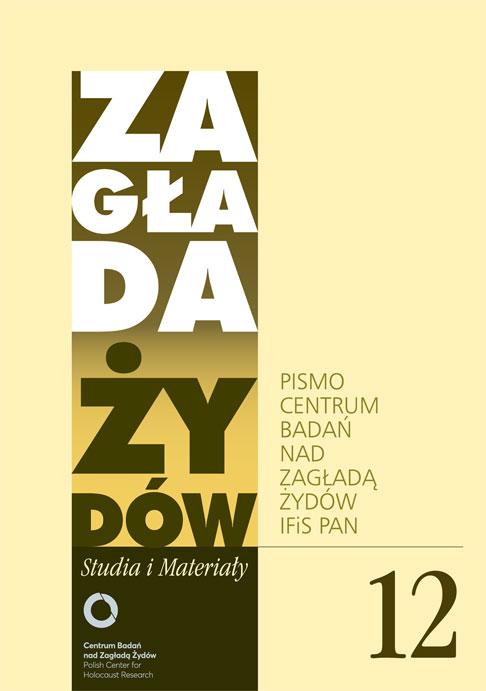Frankenstein w warszawskim getcie. Historia i legenda
Zagłada Żydów. Studia i Materiały, Nr 12 (2016), Strony: 187-208
Data zgłoszenia: 2020-10-19Data publikacji: 2016-11-30
 https://doi.org/10.32927/ZZSiM.414
https://doi.org/10.32927/ZZSiM.414
Abstrakt
The article deals with one exceptionally violent German perpetrator who was part of the occupation force in Warsaw during the Second World War. Inside the Ghetto he maltreated and killed a large number of women, children and men for his own personal pleasure. He did this to such an extensive degree that the population perceived him as monstrous being that was given the nickname „Frankenstein”. The article is mainly based on statements in juridical investigations, from the victim as well as from the perpetrator perspective, supplemented with some selected additional sources. Firstly the source corpus will be evaluated, to work out how these historical sources can be used to shed light on „Frankenstein”. This will be followed by an analysis of the actual identity of this perpetrator. It will be shown that he was, contrary to common belief, not necessarily the SS-Rottenführer Josef Blösche but more likely a member of the German Police Battalion 61. In the end the question will be also raised of how it was possible – despite all rules and regulations – that ghetto guards like him behaved like a marauding soldiery.
Słowa kluczowe
getto warszawskie , Zagłada , policja umundurowana , zbrodnie okupacyjne , warty w getcie , batalion policyjny , sprawca , przemoc , strach , terror , życie w getcie
Licencja
Prawa autorskie (c) 2016 Autor&"Zagłada Żydów. Studia i Materiały"

Utwór dostępny jest na licencji Creative Commons Uznanie autorstwa 4.0 Międzynarodowe.
https://creativecommons.org/licenses/by/4.0
Czasopismo publikowane jest w standardzie Diamond Open Access na licencji CC-BY-4.0 Deed - Uznanie autorstwa 4.0 Międzynarodowa - Creative Commons
Podobne artykuły
- Alina Skibińska, Joanna Tokarska-Bakir, “Barabasz” and the Jews: From the history of the “Wybraniecki” Home Army Partisan Detachment , Zagłada Żydów. Studia i Materiały: Nr Holocaust Studies and Materials (2013)
- Alina Skibinska, Joanna Tokarska-Bakir, „Barabasz” i Żydzi. Z historii oddziału AK „Wybranieccy” , Zagłada Żydów. Studia i Materiały: Nr 7 (2011)
- Justyna Kowalska-Leder, Wszechobecność Sprawiedliwych , Zagłada Żydów. Studia i Materiały: Nr 10 (2014)
- Agnieszka Haska, Julian Eliasz Chorążycki (1885–1943) , Zagłada Żydów. Studia i Materiały: Nr 9 (2013)
- Joanna Śliwa, Agnieszka Witkowska-Krych, Dziecko wobec Zagłady. Instytucjonalna opieka nad sierotami w getcie warszawskim , Zagłada Żydów. Studia i Materiały: Nr 19 (2023)
- Jerzy Giebułtowski, Dać przemówić faktom. O polskim wydaniu Zagłady Żydów europejskich Raula Hilberga , Zagłada Żydów. Studia i Materiały: Nr 9 (2013)
- Jakub Chmielewski, Postawy Polaków wobec Żydów w świetle okupacyjnych dokumentów na przykładzie dystryktu lubelskiego , Zagłada Żydów. Studia i Materiały: Nr 20 (2024)
- Dariusz Libionka, Encyclopedia of Camps and Ghettos 1933–1945, t. 2: Ghettos in German-Occupied Eastern Europe , Zagłada Żydów. Studia i Materiały: Nr 9 (2013)
- Andrzej Leder, Nie da się ograniczyć przemocy , Zagłada Żydów. Studia i Materiały: Nr 20 (2024)
- Grażyna Krupińska, Elisa-Maria Hiemer, Autobiographisches Schreiben als ästhetisches Problem. Jüdische Vielfalt in der polnischen und deutschen Gegenwartsliteratur [Grażyna Krupińska] , Zagłada Żydów. Studia i Materiały: Nr 17 (2021)
<< < 5 6 7 8 9 10 11 12 13 14 15 16 17 18 19 20 21 22 23 24 25 26 27 28 29 30 31 32 33 34 35 36 37 38 39 40 41 42 43 44 45 46 47 48 49 50 51 52 53 54 > >>
Możesz również Rozpocznij zaawansowane wyszukiwanie podobieństw dla tego artykułu.
 English
English
 Język Polski
Język Polski




